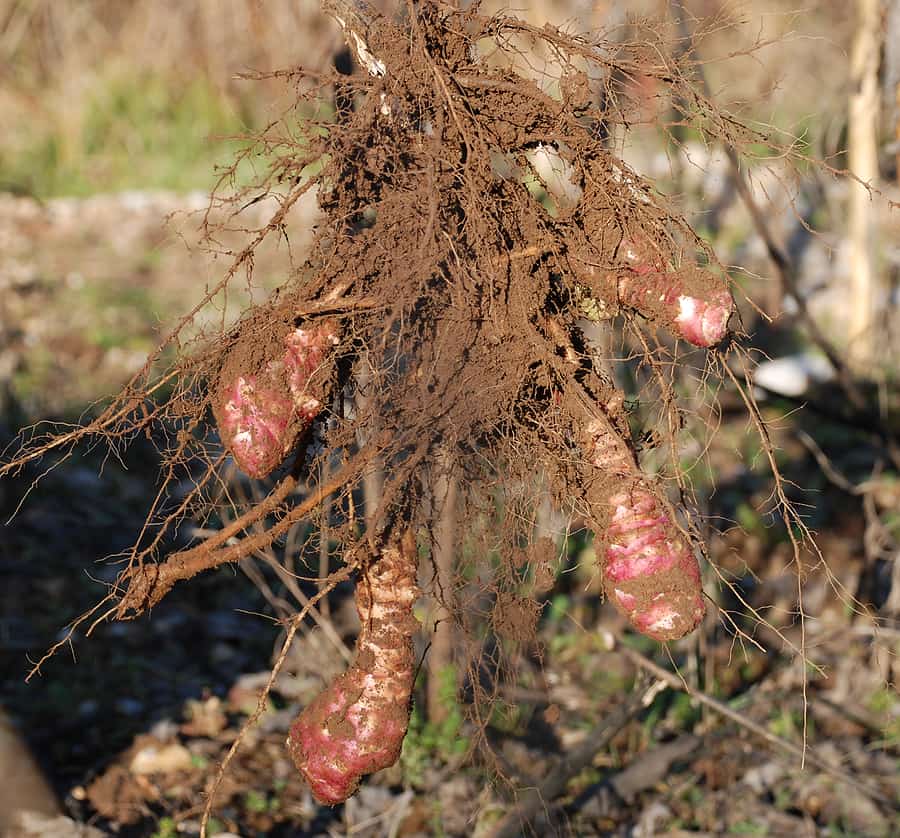Harvest Jerusalem artichokes when they are big enough to eat, about 130 days after planting. Tubers of Jerusalem artichokes—also called sunchokes–can be left in the ground past several touches of frost. They will be sweeter than those lifted sooner.
Related articles:

When to harvest Jerusalem artichokes
Harvest Jerusalem artichoke tubers from late summer onward about 13o days after planting.
Where the ground freezes, lift the entire crop before the soil freezes. Where temperatures are mild in winter, leave tubers in the ground and lift them as needed for use.
Tubers left in the garden until spring should be taken up before the weather warms otherwise they will send out new shoots, spread, and become uncontrollable and weedy.
When the first frost comes, the tops of sunchokes will begin to die back. Cut down the stems and leafy tops before you harvest. Unlike potato vines which die back as tubers mature, sunchoke plants do not die back until hit by a freeze.
Kitchen Helpers from Amazon:
- Oster Vegetable Steamer
- Chef’s Knives Set of 6
- EZ Off Jar Opener for Weak Hands
- Pepper Core Remover Stainless Steel
- Kitchen Utensils – Set of 35
- Rachel Ray Non-Stick Cookware 12pcs
How to harvest Jerusalem artichokes
- Use a spading fork to loosen the soil and lift the tubers. Start loosening the soil in a 24-inch (61 cm) circle around the stems; then work your way inward loosening the soil and lifting the tubers. Harvest when the soil is dry.
- Sunchoke tubers look like very knobby small light brown potatoes. They will be strongly attached and intertwined with the roots and soil; you will have to work to separate the tubers from the roots and stems.
- Harvest Jerusalem artichokes with gentle care—the skins are thin and can be easily cut or bruised. Tubers that are cut or bruised will not store well. Don’t lift more than you need at one time unless you have to; tubers are susceptible to rapid moisture loss and do not keep well unless put into cold storage right away.
- At harvest, remove the tops leaving about ½ inch of the crown then put tubers into storage within 3 or 4 hours.

How to store Jerusalem artichokes
- Jerusalem artichoke tubers store best at about 32°F (0°C) to 34°F and 85 to 95 percent relative humidity. Place them in plastic bags or in a container of damp sand in a cold root cellar or basement. At 32°F and high humidity, tubers will store for 2 to 5 months.
- Sunchokes stored in the refrigerator in a perforated plastic bag will keep for about 10 days.
- Tubers of the Jerusalem artichoke do not store as well as potatoes. Do not store tubes where they will dry and shrivel.
- Save a few good tubers for replanting next season.
Related articles:
How to Plant and Grow Jerusalem Artichokes – Sunchokes
Jerusalem Artichoke – Sunchoke Plant Starting Tips
How to Harvest and Store Jerusalem Artichokes – Sunchokes
Five Ways to Cook and Serve Jerusalem Artichokes – Sunchokes
Garden Planning Books at Amazon:
- Vegetable Garden Almanac & Planner
- Kitchen Garden Grower’s Guide Vegetable Encyclopedia
- Vegetable Garden Grower’s Guide
- Tomato Grower’s Answer Book
More harvest tips:
Learn when and how to harvest your favorite vegetables for the best flavor and texture. Get storage tips for each crop. Click on the vegetable you are growing below.
- Artichoke
- Arugula
- Asparagus
- Beans
- Beets
- Broccoli
- Brussels Sprouts
- Cabbage
- Cantaloupe — Melons
- Carrots
- Cauliflower
- Celery
- Chard
- Collards
- Corn, Sweet
- Cucumbers
- Eggplant
- Endive and Escarole
- Garlic
- Jerusalem Artichoke
- Kale
- Kohlrabi
- Leeks
- Lettuce
- Melons
- Okra
- Onions
- Parsnips
- Peas
- Peppers
- Potatoes
- Pumpkins
- Radicchio
- Rhubarb
- Rutabaga
- Spinach
- Squash, Summer
- Squash, Winter
- Sunchokes
- Sweet Potato
- Swiss Chard
- Tomatillo
- Tomatoes
- Turnips
- Watermelon















